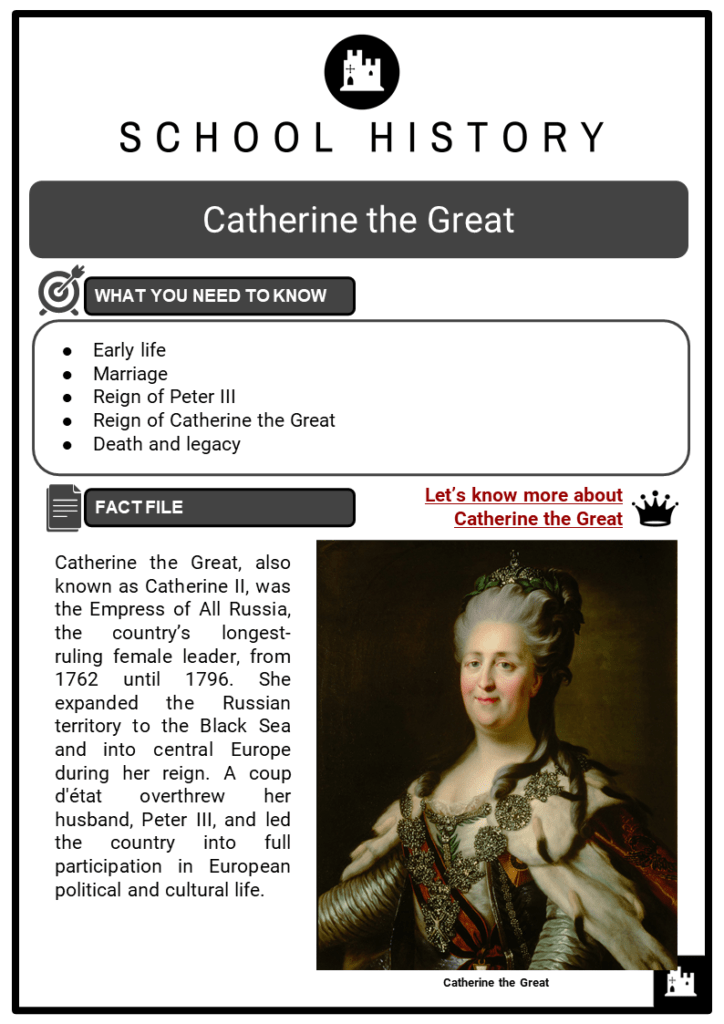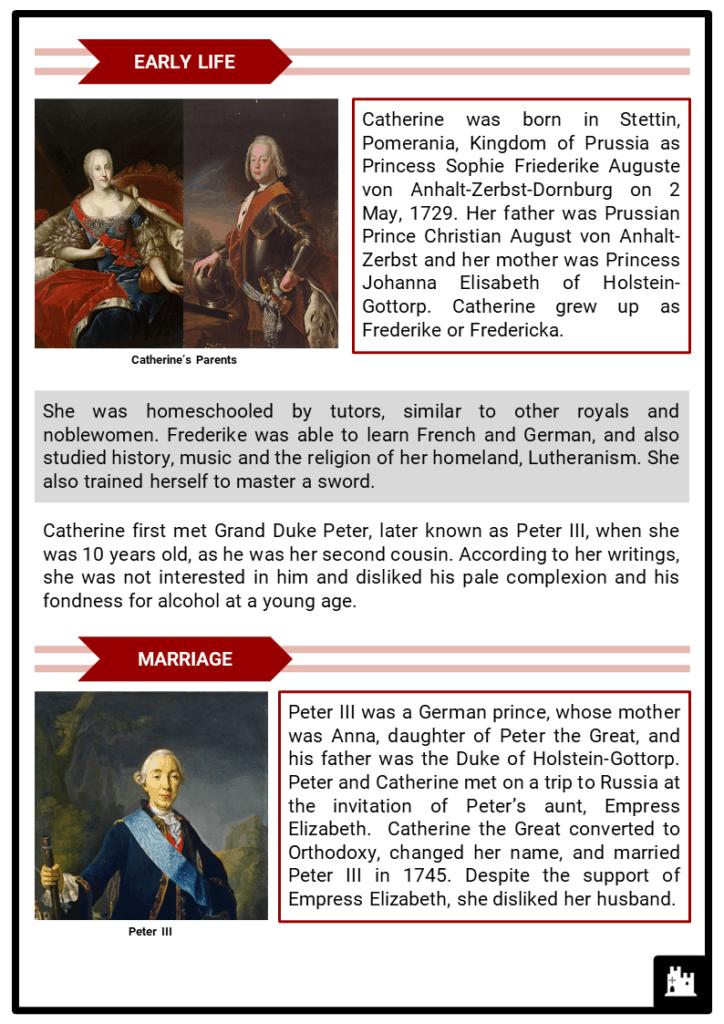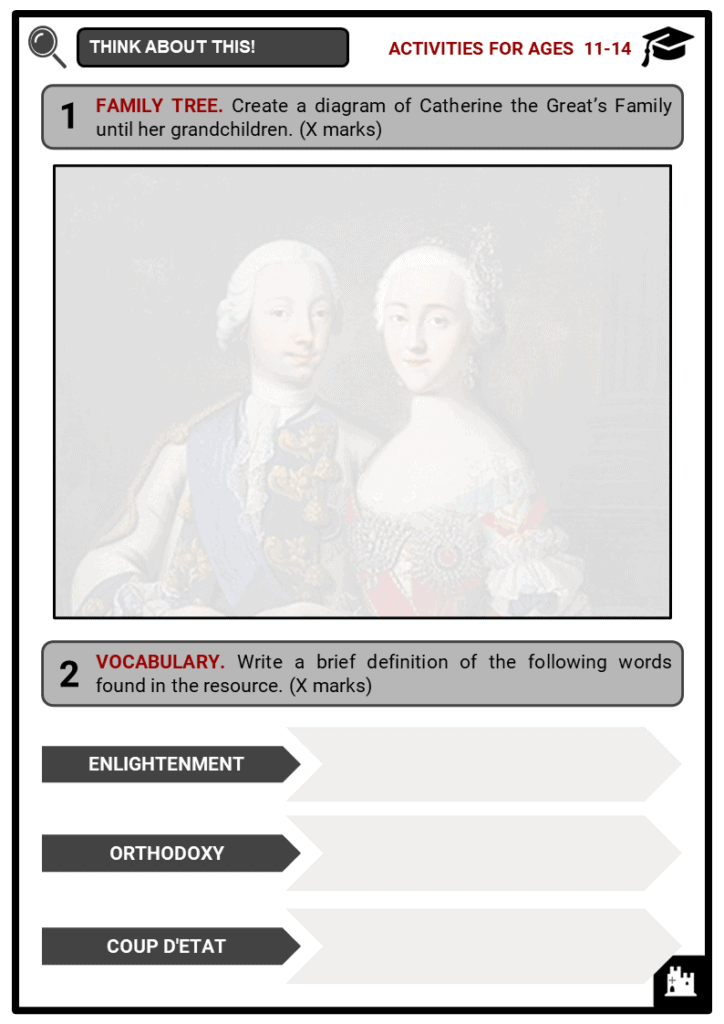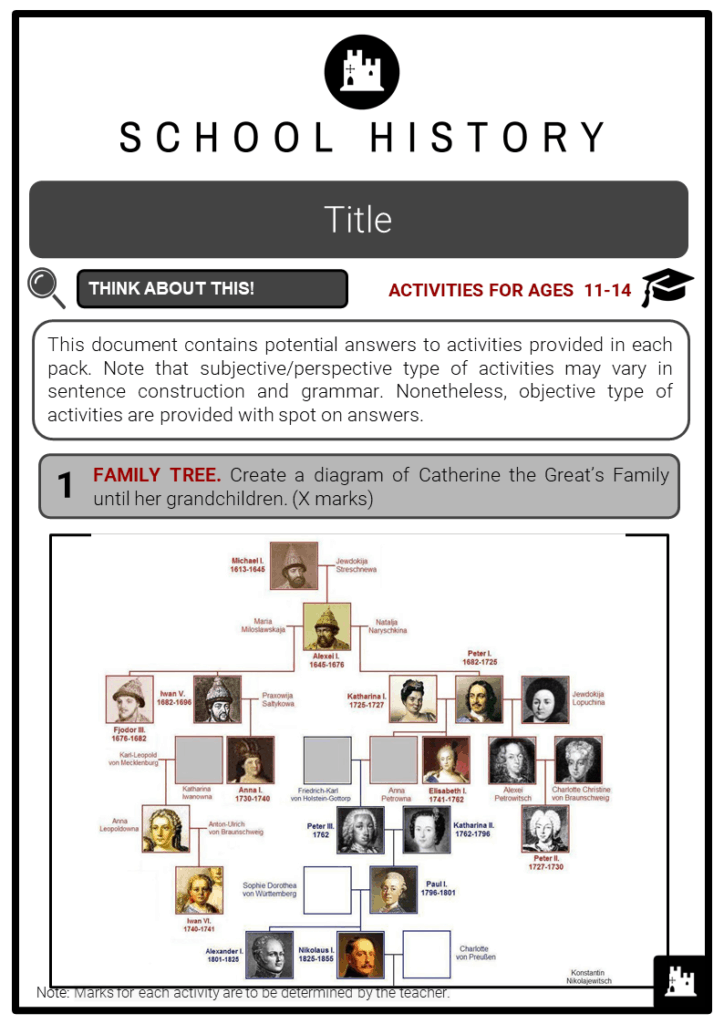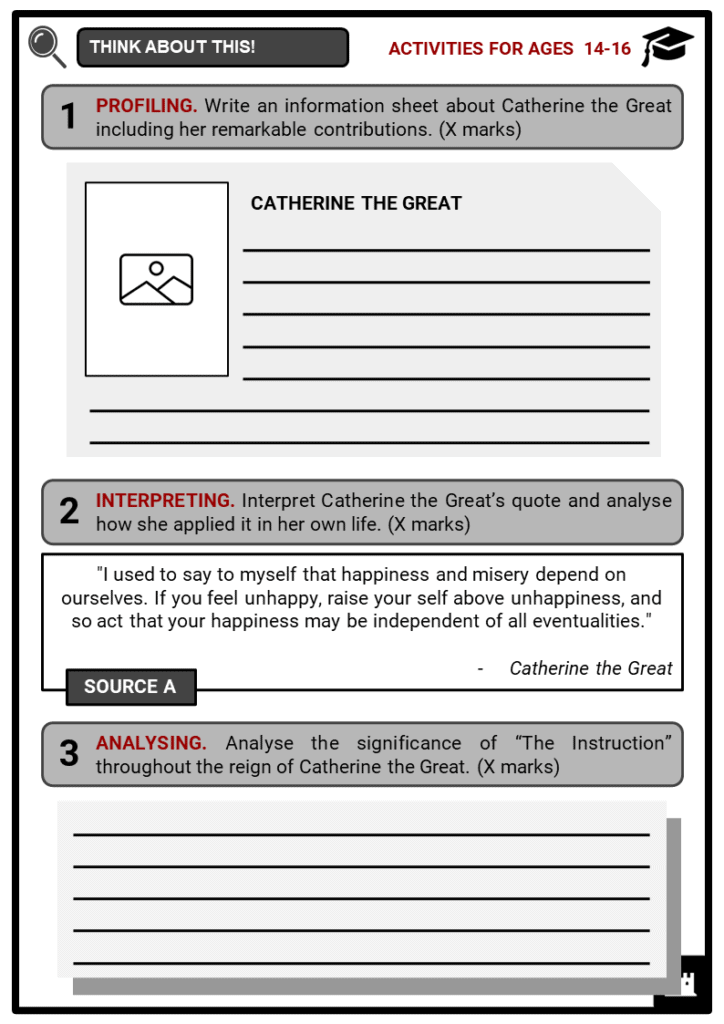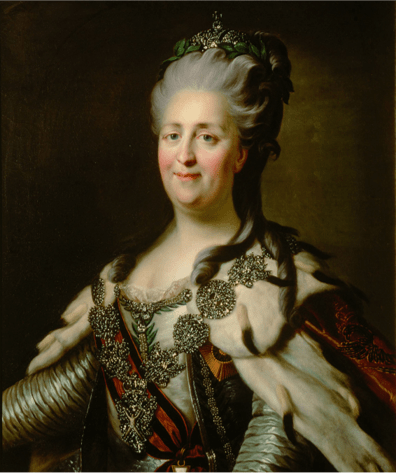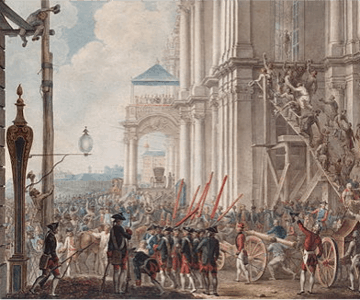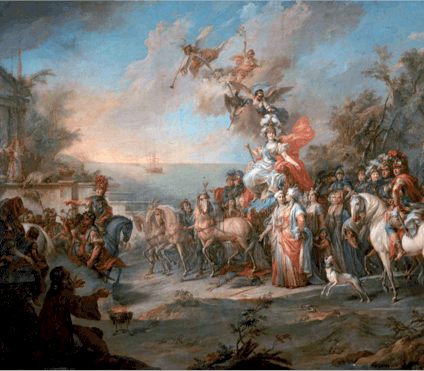Download Catherine the Great Worksheets
Do you want to save dozens of hours in time? Get your evenings and weekends back? Be able to teach Catherine the Great to your students?
Our worksheet bundle includes a fact file and printable worksheets and student activities. Perfect for both the classroom and homeschooling!
Table of Contents
Add a header to begin generating the table of contents
Summary
- Early life
- Marriage
- Reign of Peter III
- Reign of Catherine the Great
- Death and legacy
Key Facts And Information
Let’s know more about Catherine the Great!
- Catherine the Great, also known as Catherine II, was the Empress of All Russia, the country’s longest- ruling female leader, from 1762 until 1796. She expanded the Russian territory to the Black Sea and into central Europe during her reign. A coup d'état overthrew her husband, Peter III, and led the country into full participation in European political and cultural life.
Early Life
- Catherine was born in Stettin, Pomerania, Kingdom of Prussia as Princess Sophie Friederike Auguste von Anhalt-Zerbst-Dornburg on 2 May, 1729. Her father was Prussian Prince Christian August von Anhalt-Zerbst and her mother was Princess Johanna Elisabeth of Holstein-Gottorp. Catherine grew up as Frederike or Fredericka.
- She was homeschooled by tutors, similar to other royals and noblewomen. Frederike was able to learn French and German, and also studied history, music and the religion of her homeland, Lutheranism. She also trained herself to master a sword.
- Catherine first met Grand Duke Peter, later known as Peter III, when she was 10 years old, as he was her second cousin. According to her writings, she was not interested in him and disliked his pale complexion and his fondness for alcohol at a young age.
Marriage
- Peter III was a German prince, whose mother was Anna, daughter of Peter the Great, and his father was the Duke of Holstein-Gottorp. Peter and Catherine met on a trip to Russia at the invitation of Peter’s aunt, Empress Elizabeth. Catherine the Great converted to Orthodoxy, changed her name, and married Peter III in 1745. Despite the support of Empress Elizabeth, she disliked her husband.
- Paul I was born nine years after their marriage and a lot of people doubted that Peter was the father. Her second child, Anna, was likely to be the daughter of Stanislaw Poniatowski. Her youngest child, Alexei, was likely to be the son of Grigory Orlov. However, all three were officially recorded as Peter’s children.
- Catherine wrote that she was more interested in the crown and that she was unfaithful. Catherine was known to be miserable during their marriage as she had to deal with his immature attitudes, such as playing with toy soldiers, and alcoholism.
Reign Of Peter Iii
- Peter became known as Emperor Peter III when he ruled and took over the position of Czarina Elizabeth as she died in 1761, and Catherine became the Empress consort. Peter III immediately ended Russia’s war with Prussia, which angered the military and the nobles, and concluded an alliance with Frederick II of Prussia.
- Peter’s hatred of Russia and love of his native Germany was very obvious and he also wanted to divorce Catherine. While Peter lost most of his supporters, Catherine had the support of Grigory Orlov, her lover, who was stationed at St. Petersburg.
- Peter’s careless actions led to a coup against him where military, church and government leaders successfully removed Peter III from the throne. Their son, Paul, was supposed to be his replacement but with the help of Orlov, Catherine was able to take over and Paul became her heir.
- In 1762, Catherine led the regiments that had rallied to her cause into St. Petersburg, where Peter III was situated, and had herself proclaimed empress and autocrat in the Kazan Cathedral. She was also supported by the “enlightened” elements of aristocratic society due to her liberal opinions and she was admired as one of the most cultivated persons in Russia.
- Eight days later, Peter III was strangled to death. Although Catherine might not have been behind the murder, it was thought to have been committed by her supporters.
Reign Of Catherine The Great
- The early years of Catherine as the empress were devoted to gaining military and mobility support to strengthen her claims. Her ministers handled domestic and foreign policies which were designed to establish stability and peace. Some of these were instituted reforms inspired by the Enlightenment, and updated the Russia’s legal system to provide equality of people under the law.
- In June 1767, Empress Catherine established the Legislative Commission whose main goal is to revise the old laws in accordance with the “Instruction” – Catherine’s proposed system that provides equal protection under the law for all persons.
- The Instruction was widely known in Europe and caused a sensation due to its call for a legal system and also emphasised the prevention of criminal acts rather than the harsh punishments for them.
- Catherine eventually suspended the Legislative Commission meetings at the end of 1768 since they made only little progress.
- Foreign and Domestic Affairs
- In 1768, Catherine the Great sent troops to Polish King Stanislaw, her former lover, to help him suppress a revolt which aimed to reduce Russia’s influence in Poland.
- The rebels had Turkey’s support and the Turks declared war on Russia.
- When the Turkish Troops were defeated, the Austrians threatened Russia with war.
- In 1772, Russia and Austria partitioned Poland.
- Catherine was able to conclude peace talks after lengthy negotiations in 1774.
- The peace treaty also included that Russian merchant ships had the right to sail on the Black Sea and through the Dardanelles.
- Cossack Yemelyan Pugachev led a revolt at home before the peace treaty was signed. He claimed that the death of Peter III was false and that he himself was Peter III. His claim had thousands of supporters and the uprising was within threatening range of Moscow. It took several battles to defeat this rebellion and Catherine backed off from a lot of reforms to benefit that stratum of society.
- Russo-Turkish Wars
- Peter the Great had been able to make a move in the south, at the edge of the Black Sea, and Catherine completed this conquest of the south.
-
- This led Russia to dominate south-eastern Europe at the end of the Russo-Turkish War of 1768-1774.
- Catherine the Great sought the support of Austria in moving against Turkey and planned to seize Turkey's European lands.
- During that time, Austria and the other European powers had withdrawn their alliance with Russia.
- Due to the loss of alliance, Catherine’s plan to take over lands as far as Constantinople did not happen.
- Polish nationalists then rebelled against Russia.
- Russia and Prussia annexed more Polish territory in 1793. Russia, Prussia and Austria annexed the rest of Poland in 1794.
Death And Legacy
- Catherine the Great was worried that her son, Paul, was not emotionally fit to rule so she planned to replace him with his son, Alexander, as her heir. However, Catherine died from a stroke on 17 November 1796 before she could make the change. Paul ascended to the throne and was known as Emperor Paul I. Catherine’s will was discovered in early 1792 and included instructions regarding her funeral.
- "Lay out my corpse dressed in white, with a golden crown on my head, and on it inscribe my Christian name. Mourning dress is to be worn for six months, and no longer: the shorter the better."
- Catherine the Great’s life and reign included remarkable successes and Russians continue to admire her for increasing their country’s boundaries. Catherine was also a patron of literature who promoted Russian culture and, along with British Queens Elizabeth I and Victoria, was one of the few women to do so.
- Though others acknowledged her successful administrative ability, they also saw her negative traits, such as being harsh, egotistical, pretentious and domineering. Some also described her as a woman of action who could be ruthless when it served her or the state.
Image sources:
- https://en.wikipedia.org/wiki/File:Catherine_II_by_J.B.Lampi_(1780s,_Kunsthistorisches_Museum).jpg
- https://en.wikipedia.org/wiki/Catherine_the_Great#/media/File:%D0%95%D0%BA%D0%B0%D1%82%D0%B5%D1%80%D0%B8%D0%BD%D0%B0_%D0%BD%D0%B0_%D0%B1%D0%B0%D0%BB%D0%BA%D0%BE%D0%BD%D0%B5.jpg
- https://upload.wikimedia.org/wikipedia/commons/thumb/6/65/Torelli2.jpg/580px-Torelli2.jpg

